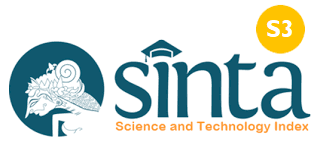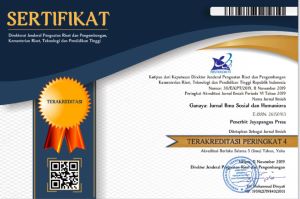Analisis Implementasi Kebijakan Program Percepatan Penurunan Stunting Terintegrasi Di Kabupaten Sidoarjo
DOI:
https://doi.org/10.37329/ganaya.v8i1.3790Keywords:
Policies, Stunting, Work ProgramsAbstract
This study aims to analyze the implementation of the Integrated Stunting Reduction Acceleration Program policy in Sidoarjo Regency using a qualitative descriptive approach. The research employs Policy Implementation theory, which encompasses communication, resources, disposition, and bureaucratic structure. The qualitative research method used is descriptive, with data collected through interviews, observations, and documentation. The findings reveal that policy communication has been effectively conducted, although significant challenges remain at the village level, particularly regarding public understanding and participation. Human and non-human resources are considered adequate; however, their distribution remains uneven and requires improvement to achieve optimal effectiveness. The implementers' disposition shows a high level of commitment to the program, but transparency in policy implementation remains a challenge to be addressed. The bureaucratic structure has supported coordination among stakeholders, although some procedures are perceived as overly complex and need simplification to improve implementation efficiency. The implementation of the Integrated Stunting Reduction Acceleration Program in Sidoarjo Regency reflects the local government's strong commitment to addressing nutritional challenges through a holistic approach. This program targets a reduction in the stunting rate to 14% by 2024, employing various measures such as the Bangga Kencana Consolidation, Convergence of Stunting Reduction Acceleration, and intensive public awareness campaigns. Regular evaluations have shown positive results, including a significant decrease in the stunting rate from 16.1% in 2022 to 8.4% in 2023. By integrating relevant sectors and actively involving the community, this strategy has proven effective in creating an environment that supports optimal child growth. With improvements in these three aspects, the effectiveness of policy implementation is expected to increase, enabling the program to have a more significant impact on reducing stunting rates in Sidoarjo Regency.
References
Abdussamad, J., Hurudji, A., & Putri, W. (2022). Implementasi Kebijakan Penyelenggaraan Kepariwisataan Di Desa Botutonuo Kabupaten Bone Bolango. Publik: Jurnal Manajemen Sumber Daya Manusia, Administrasi dan Pelayanan Publik, 9(2), 157-178.
Affrian, R. (2024). Implementasi Kebijakan Ketertiban Umum Dan Ketentraman Masyarakat Di Kabupaten Hulu Sungai Tengah (Studi Warung Remang-Remang Di Desa Sungai Buluh). Jurnal Niara, 16(3), 520-524.
Anam, K., & Rodiyah, I. (2024). Implementasi Kebijakan Sistem Zonasi Di Kabupaten Sidoarjo. Jurnal Ilmu Sosial dan Ilmu Politik Malikussaleh (JSPM), 5(1), 199-213.
Anita, A., Aprina, A., Sudarmi, S., Rusyantia, A., Pranajaya, P., & Astuti, T. (2024). Analisis Implementasi Kebijakan Swasembada Gizi dalam Upaya Pencegahan dan Penanggulangan Stunting di Kabupaten Lampung Selatan. MAHESA: Malahayati Health Student Journal, 4(3), 1007-1025.
Ardhana, R., & Hertati, D. (2021). Implementasi Kebijakan Penataan Minimarket di Kabupaten Sidoarjo. Jurnal Governansi, 7(2), 131-142.
Arini, D., Chabibah, N., & Agustin, M. A. (2020). Analisa Determinan Sosial Demografi Ibu terhadap Kejadian Stunting pada Anak Usia Toddler di Wilayah Puskesmas Kenjeran Surabaya. Journal Of Health Science (Jurnal Ilmu Kesehatan), 5(1), 1-10.
Darmansyah, E., & Yusran, R. (2024). Implementasi Kebijakan Kampanye Perubahan Perilaku dalam Upaya Penurunan Stunting di Puskesmas Danau Kerinci Barat. Jurnal Administrasi Pemerintahan Desa, 5(1), 10-10.
Hapsari, N., Waris, I., & Alamasyah, N. (2024). Implementasi Kebijakan Pengelolaan Pertambangan Minerba di Kelurahan Poboya, Kecamatan Mantikulore Kota Palu. CENDEKIA: Jurnal Penelitian dan Pengkajian Ilmiah, 1(5), 240-253.
Hermawan, K. T., & Pusparani, I. G. (2023). The Implementasi Kebijakan Percepatan Penurunan Stunting di Kota Cirebon. Jurnal Borneo Akcaya, 9(2), 233-248.
Iqbal, M. (2022). Evaluasi Program Zinc Sebagai Intervensi Gizi Khusus Dalam Pencegahan Stunting Pada Program Gerakan 1000 Hari Pertama Hidup (HPK) di Puskesmas Halmahera Kota Semarang. Jurnal Manajemen Kesehatan Yayasan RS. Dr. Soetomo, 8(2), 309-317.
Krosby, S. S., Rahmi, S. A., & Mintasrihardi, M. (2024). BahasImplementasi Kebijakan Percepatan Pencegahan Stunting Terintegrasi di Kota Matarama Indonesia. Jurnal Ilmiah Tata Sejuta STIA Mataram, 10(1), 29-43.
Larasati, N., & Susilo, A. T. H. (2024). Implementasi Agenda Internasional Stunting di Indonesia: Studi Kasus Kabupaten Malang Kecamatan Tajinan. Jurnal Sehat Indonesia (JUSINDO), 6(01), 293-307.
Mamulaty, A., Rengifurwarin, Z. A., & Normawati, N. (2024). Analisis Implementasi Kebijakan Penurunan Stunting di Desa Wamsisi Kecamatan Waesama Kabupaten Buru Selatan. Jurnal Ilmiah Global Education, 5(1), 587-601.
Maulana, M. A., & Santosa, S. H. (2020). Explaining Legal Implications: Ownership Analysis Of Intellectual Property Rights On Cryptokitties Platforms. Future Generation Computer Systems, 102, 259-77.
Mitra, M., Nurlisis, N., & Rany, N. (2022). Edukasi Online tentang Persiapan Laktasi Ketika Hamil untuk Keberhasilan ASI eksklusif dan Pencegahan Stunting. Empowerment: Jurnal Pengabdian Masyarakat, 1(4), 475-481.
Nurizal, I., Dermawanaryo, A., Ilahi, M. R. S., Widari, D. K., Andayani, N. L. W., Rahmatun, F., Herlinda, T., & Ferinadivia, D. (2022). Optimalisasi Program Pencegahan Stunting oleh KKN-T UNRAM Bersama Puskesmas Kecamatan Sambelia dan para Kader Posyandu di Desa Sambelia Kecamatan Sambelia. Jurnal Pengabdian Magister Pendidikan IPA, 5(3), 157-161.
Prasiwi, S. D., Mursyidah, L., & Sutanto, S. H. (2024). Implementasi Kebijakan Perizinan Usaha Mikro dan Kecil Berdasarkan Peraturan Pemerintah Nomor 5 Tahun 2021 (Studi Usaha Mikro dan Kecil Topi di Desa Punggul, Kabupaten Sidoarjo). CAKRAWALA, 18(1), 59-73.
Purwati, N., Syukron, A., Widodo, P., & Kuwwaamri, S. (2024). Implementasi Aplikasi Peringatan Dini Stunting Balita Data pada Posyandu Desa Pejengkolan. Jurnal Abdimas BSI: Jurnal Pengabdian Kepada Masyarakat, 7(1), 99-106.
Downloads
Published
How to Cite
Issue
Section
License
Copyright (c) 2025 Fajar Muharram, Siti Cholifah, Purnama Julia Utami (Author)

This work is licensed under a Creative Commons Attribution-ShareAlike 4.0 International License.
An author who publishes in the Ganaya : Jurnal Ilmu Sosial dan Humaniora agrees to the following terms:
- Author retains the copyright and grants the journal the right of first publication of the work simultaneously licensed under the Creative Commons Attribution-ShareAlike 4.0 License that allows others to share the work with an acknowledgement of the work's authorship and initial publication in this journal
- Author is able to enter into separate, additional contractual arrangements for the non-exclusive distribution of the journal's published version of the work (e.g., post it to an institutional repository or publish it in a book) with the acknowledgement of its initial publication in this journal.
- Author is permitted and encouraged to post his/her work online (e.g., in institutional repositories or on their website) prior to and during the submission process, as it can lead to productive exchanges, as well as earlier and greater citation of the published work (See The Effect of Open Access).
Read more about the Creative Commons Attribution-ShareAlike 4.0 Licence here: https://creativecommons.org/licenses/by-sa/4.0/.








